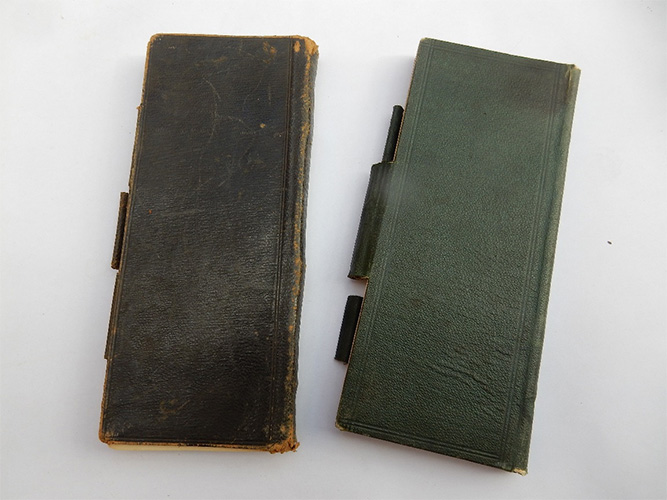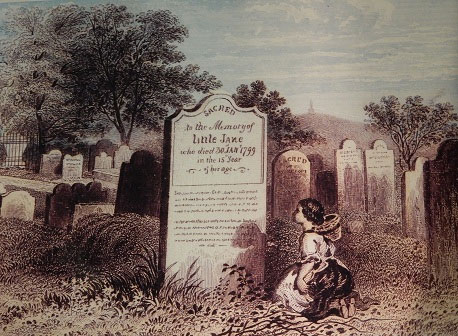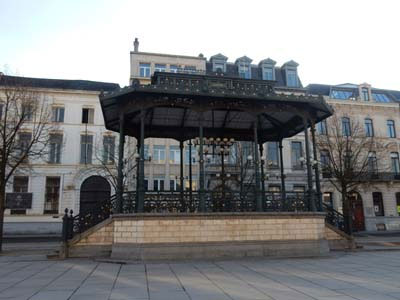3. Travel Journals

Figure 1 1836 autumn tour journal (left) and Wedding tour 1837 (right)
Physical Description
Both notebooks are 7ins by 3ins containing approximately 160 pages each with 24 lines. The hard covers have one loop in the middle on one side and two on the other side for secure closure by a pen through all three loops.
The 1836 journal is covered in black leather and on the lower inside of the board which has one loop, is a label, 'Sold by Spiers & Son 103 High St. Oxford.' Then follows a list of expenses, both joint and single, and a short list of attractively displayed food. The daily entries can be seen by inverting the journal.
The 1837 one is cheaper having a dark green cloth cover and on the board to which the single loop is attached is a printed label listing the current Stamp Duty rates. There is no seller's label. The daily entries follow and the seven pages of columns with proposed and actual routes and a list of books can be seen by turning the notebook upside down.
Why were they written?
Spiers liked to compile journals of his trips and to present them well for reading out and being read. In June 1835 he had made a trip to Lechlade, Cirencester, Bristol and Cheltenham with his sister Anne Patey later Mallam (1807-1881) and in 1839 he recorded in his diary
[July] 13
Miss & Ann Gearing [of Lechlade] came to Oxford at 11. A merry evening with my Lechlade journal & reminiscences
In 1862 he read from his diary to his children about their dead mother – so the journals and diary were part of family life.
He constructed the journals from his own daily notes, guide books bought on the tour and travel books and handbooks, sometimes long after the event. The 'Spiers & Son, 103 High Street' label inside the 1836 journal shows that it was written some time after 1846 when that shop was bought. Lack of free time is an obvious reason for delay and perhaps his companion Edward Standen's early death made him realise his own mortality and write up their tour.
Although he noted that he and Elizabeth both spent time writing up their journals on their wedding tour in 1837, this is a version written later and sometimes he wearied of it.
SAT: JULY 22 A pleasant voyage had we down this river [Thames] which I have seen so many times that I care not to describe it, and added to this reason there are times and seasons when one is not inclined for any thing that is required. This is my misfortune now, to find the writing of this diary irksome.
After the entry for 26 July he moves from writing on both sides of the page to verso only, perhaps like a schoolboy wanting to get to the end more quickly and finish his task. Except he did not finish, leaving out the last six weeks. There is no indication of when he wrote this journal. All the books listed at the end were available by 1837 but if Ramble in Germany is the one by Mary Shelley, this was not published until 1844.
The journals show more of Spiers' personality than the tightly edited diary and his interests, adventures and sense of fun come across vividly.
Memoranda of an autumn tour in 1836.
Richard James Spiers (1806-1877) hair dresser and perfumer, travelled to Germany for a walking tour with Edward Standen (1809-1845), mercer and shirtmaker, 28 High Street, who had married his sister Katharine Sirman Spiers later Willins (1811-1857), in 1833.
The main part of the journal records their travels and adventures from Oxford on 9 August 1836, ending in Frankfurt on 26 August when the list of joint expenses ends. He continued on alone for his expenses carry on to 25 September and he was back in Oxford for his mother's birthday trip to Nuneham on 26 September. The solo trip seems as much business as pleasure as he purchased trunks and posted goods back to Oxford.
After the Grand Tour of the 18th century for the upper classes, the middle classes toured Europe in the 19th and handbooks with advice on all aspects of travelling and staying in countries were published. John Murray's A Handbook of..... series was started in 1836 and updated frequently while individual travellers wrote about their experiences like Henry Inglis in Solitary Walks through Many Lands (1828) and Sir Francis Bond Head in Bubbles from the Brunnens of Nassau (1834).

Figure 2 Porta Nigra, Trier (© Alex Tihonovs/shutterstock.com)
So although it seems that Spiers and Standen were striding off into the unknown, they were well informed about routes, timings and accommodation, and met many others touring, some walking like themselves. Spiers spoke French and German though he appreciated help from two English brothers studying at Frankfurt in understanding the fast flowing conversation at a dinner table. By dressing in workmen's blouses and hats, with little to carry, they moved easily through the countryside and were mistaken for Germans by two travellers from Oxfordshire on 26 August.
To read the journal click here [link to new pages]
Journal of my wedding tour 1837
On 15 July 1837, Richard James Spiers married Elizabeth Phené Joy (1818-1858) at St Cross church, Holywell, and they set off immediately on their wedding trip which lasted two and a half months. Spiers was an experienced traveller on the continent and he took Elizabeth to some familiar places where he knew the language but perhaps Italy was unknown to him for in April 1837 he had his first Italian lesson. After their first week together in the Isle of Wight, they were joined in London by Elizabeth's aunt, Sarah Joy née Colbourne (1794-1867) and cousin, Martha Joy later Mallam (1819-1893), who travelled with them to Wiesbaden in Germany where her uncle William Joy (1780-1847), a tailor, joined them on 7 August. The newly-weds immediately set off on their own but the journal ends in Frankfurt on 11 August even though they did not return to Oxford until 25 September, when he writes in his diary,
Returned home at 9.15, where all were waiting to receive me.
It is surprising to modern eyes that he writes 'me' rather than 'us'. After providing him with 13 children in 20 years Elizabeth dropped dead when only 40.
To read the journal click here [links to new pages]
Notes on Editing
Where a word is indecipherable, its position is indicated by […].
Where a guess has been made as to the word, it is preceded by '?'.
Spelling matches that in the original except for place-names otherwise not readily identifiable.
Words deleted by Spiers have been omitted.
Editorial comment is within these brackets: […].

Figure 3 Little Jane's grave at Brading, Isle of Wight, visited by the newlyweds on 17 July 1837

Figure 4 Bandstand in the Kouter (Place d'Armes), Ghent. The Spiers' stayed at the Hotel de Poste (since demolished) in the square, and one evening listened to the band playing there – though not in this bandstand, erected in 1882, 45 years after their visit (25 July).
Oxfordshire Architectural and Historical Society is a registered charity, No 259055.
All Rights Reserved © OAHS 2010-2025
Privacy Policy
Committtee Login